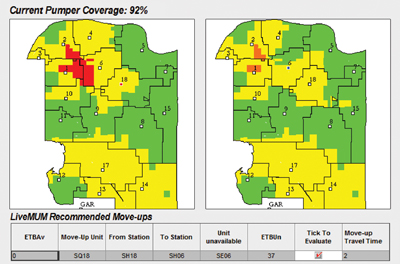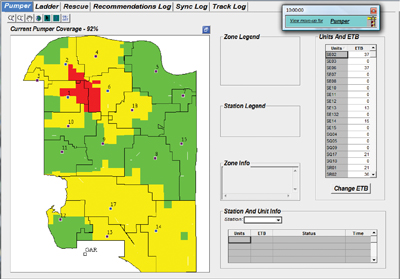
Features
Hot topics
Research
Moving up
It’s Thursday morning in Surrey, B.C., and three Surrey Fire Services (SFS) units are responding to a residential structure fire in the city’s northwest.
December 5, 2011
By Len Garis Joseph Clare and Raj Nagaraj
Editor’s note: This article builds on an April 2008 story in Canadian Firefighter and EMS Quarterly that explained Surrey Fire Service’s use of the LiveMUM decision-making tool for optimum coverage. After four years of use, Surrey summarizes the positive findings of an evaluation of LiveMUM.
It’s Thursday morning in Surrey, B.C., and three Surrey Fire Services (SFS) units are responding to a residential structure fire in the city’s northwest. At the same time, in the south of the city, another four units are responding to a motor vehicle accident and an alarm call. From an operational perspective, how does the duty chief determine whether the remainder of the city’s resources are located where they will provide optimal coverage? What are the risks of another call occurring? Should empty halls be backfilled? Can on-duty resources be temporarily redistributed to improve coverage?
In years past, such questions were answered based on gut feelings and experience, with huge variations from one instance to the next. At an extreme, such a situation would have been addressed by initiating full standby coverage for all empty halls.
However, since 2007, this has not been the case for Surrey Fire, where operational decision making has been guided by a probability-driven, real-time resourcing decision-making tool called the Live Move-Up Module (or LiveMUM, created by Deccan International – www.deccanintl.com).
This model uses past calls for service, across time and space, to calculate the probability that resource gaps have emerged as a consequence of current resourcing demands. If such gaps are identified, LiveMUM then makes recommendations about reallocating the remaining resources to improve coverage.
This process is achieved through recommending move-ups, which involve temporarily relocating resources from one station to another to provide emergency coverage when and where it is required.
From the outset, Surrey Fire management has been very satisfied with the performance of LiveMUM and the results of a recently completed evaluation have justified this position. Analysis of 2010 data revealed LiveMUM had an overall net positive impact on response times and reduced incidence of indiscriminate backfilling. In short, probability-driven, pre-emptive allocation of resources around the city has maximized operational cost efficiencies and improved firefighter coverage.
 |
|
| Figure 1. LiveMUM pop-up window, advising of the coverage gap and effective solution.
|
The scope of the coverage problem
Surrey is the second-largest city in British Columbia and the 12th largest city in Canada. Its 17 fire stations provide coverage for 317.4 square kilometres and a population of about 475,000 (see Figure 1 for the coverage areas for the 17 fire halls in Surrey). Although calls for service are unevenly distributed across time and space, analysis of historical data demonstrates that there is predictability to these distributions.
The underlying logic of LiveMUM
Using this knowledge, LiveMUM aims to achieve three goals:
- Maximize coverage across the city;
- Minimize the number of vehicle move-ups;
- Minimize the travel times involved when vehicle move-ups are recommended.
LiveMUM interacts with the city’s computer-aided dispatch system in real time to determine when and where move-ups are necessary. For example, when the closest units to a particular neighbourhood will not be available for a significant period of time, a move-up is recommended. At the same time, LiveMUM’s risk-assessment tool helps to ensure that any relocated resources will actually be put to use. This critical component relies on historical data to calculate the probability of a second call occurring in an area when units are already in use. This calculation looks at the time of day and geography of previous calls. Move-ups into particular areas are recommended at times/days when the area’s call volume is typically high, but not when volume is typically low.
The system employs Bayesian statistics, which are an approach to probabilistic inference that determines the likelihood of a future event occurring based on past incidences of the event. LiveMUM applies this approach, recommending a move-up if the probability of a call occurring is above the specified threshold (to date this threshold has been set by Surrey Fire at 25 per cent likelihood of a resource being required in the area).
If the likelihood of requiring additional resources in an area that is currently not covered exceeds this risk threshold, then a second decision is required: where should resources be moved from in order to address the probabilistically determined need? This recommendation is made based on the combination of available alternatives and is motivated by a need to avoid simply shifting the resourcing coverage problem to a different part of the city. An underlying safeguard in this process is that LiveMUM is never going to worsen coverage, and, as such, will never move a “must-cover” unit.
 |
|
| Figure 2. Detailed station-by-station unit information and colour-coded coverage gaps indicated by LiveMUM.
|
What the dispatchers experience
From an operational perspective, LiveMUM functions by displaying a colour-coded map (see Figure 2) that allows dispatchers to see the various levels of move-up necessity for different types of apparatuses in real time across the city. For example, per customized Surrey Fire Service configuration rules, if two adjacent fire halls respond to a call, a red colour on the map indicates where an engine move-up is required, based on the probability of a call occurring while the responding units are in use elsewhere. Orange indicates if a move-up is not necessary due to historical call infrequency at that time. Colour coding also shows where the level of coverage is acceptable (yellow) and optimal (green) throughout the service area.
Also, fire stations on the map are colour coded to indicate whether there are available units, no available units, or no units assigned.
Detailed station-by-station unit information is also available, as is on-screen monitoring of a move-up in progress (see Figure 1).
From a dispatcher’s perspective, LiveMUM will pop up a window advising of the coverage gap (see Figure 1). The system accommodates multiple concurrent scenarios – an important feature for a department the size of Surrey – and the dispatcher can cycle through alternatives as required before making the call to the appropriate units to move up as required.
Improved responses and cost efficiencies
SFS wanted to examine the impact of LiveMUM on responses to calls for service in 2010 – a total of 28,902 incidents, of which 10,164 (35 per cent) involved an engine-capable unit. Depending on the timing and typical coverage requirements of incidents, gaps in coverage occurred. As a consequence, LiveMUM initiated 422 engine move-ups (an average of 1.15 per day), 81 of which resulted in a response by the moved-up engine unit. This meant that 19 per cent of the time an engine unit was moved up in 2010, it was located in the correct area of the city to ensure better overall response times were attained.
In addition to providing better coverage, LiveMUM reduced unnecessary backfilling of stations. Data from 2002 revealed that prior to implementation of LiveMUM, call-back resources were used 52 per cent of the time. In comparison, the call-back rate for 2010 increased to 92 per cent, a 77 per cent improvement. The net result of this was to maximize the effectiveness of the cost associated with backfilling empty fire halls.
Conclusions and future applications
Therefore, LiveMUM has enabled Surrey Fire Service to dynamically manage its resources and maintain a high level of coverage while minimizing downtime. Surrey Fire is now working with Deccan International to fine-tune the decision-making criteria for the initiation of move-ups to further enhance these positive effects.
From a broader planning and economic perspective, tools such as LiveMUM are becoming increasingly valuable in light of the economic downturn, which is forcing the fire service to find more efficient ways to deliver services. LiveMUM enables Surrey Fire to dynamically apply its resources in an efficient, targeted manner, with no net reduction of service.
Moving beyond the specifics of fire, there is obvious potential for using a similar probabilistic approach to resource allocation for other emergency first responders. LiveMUM is fully compatible with automatic vehicle locators and/or computer-driven dispatch, and has the potential to be used across governmental boundaries (for example, for mutual aid) and across service providers (EMS and fire).
Furthermore, the principles that underlie the successful application of Bayesian modelling in LiveMUM, such as the non-random distribution of calls for service over time and space, are equally applicable to these other services, which are also attempting to meet service needs across a pre-defined area with finite resources.
Len Garis is the fire chief for the City of Surrey, B.C. Contact him at LWGaris@surrey.ca
Dr. Joseph Clare is a strategic planning analyst for Surrey Fire Service.
Dr. Raj Nagaraj is director of engineering with Deccan International.
Print this page